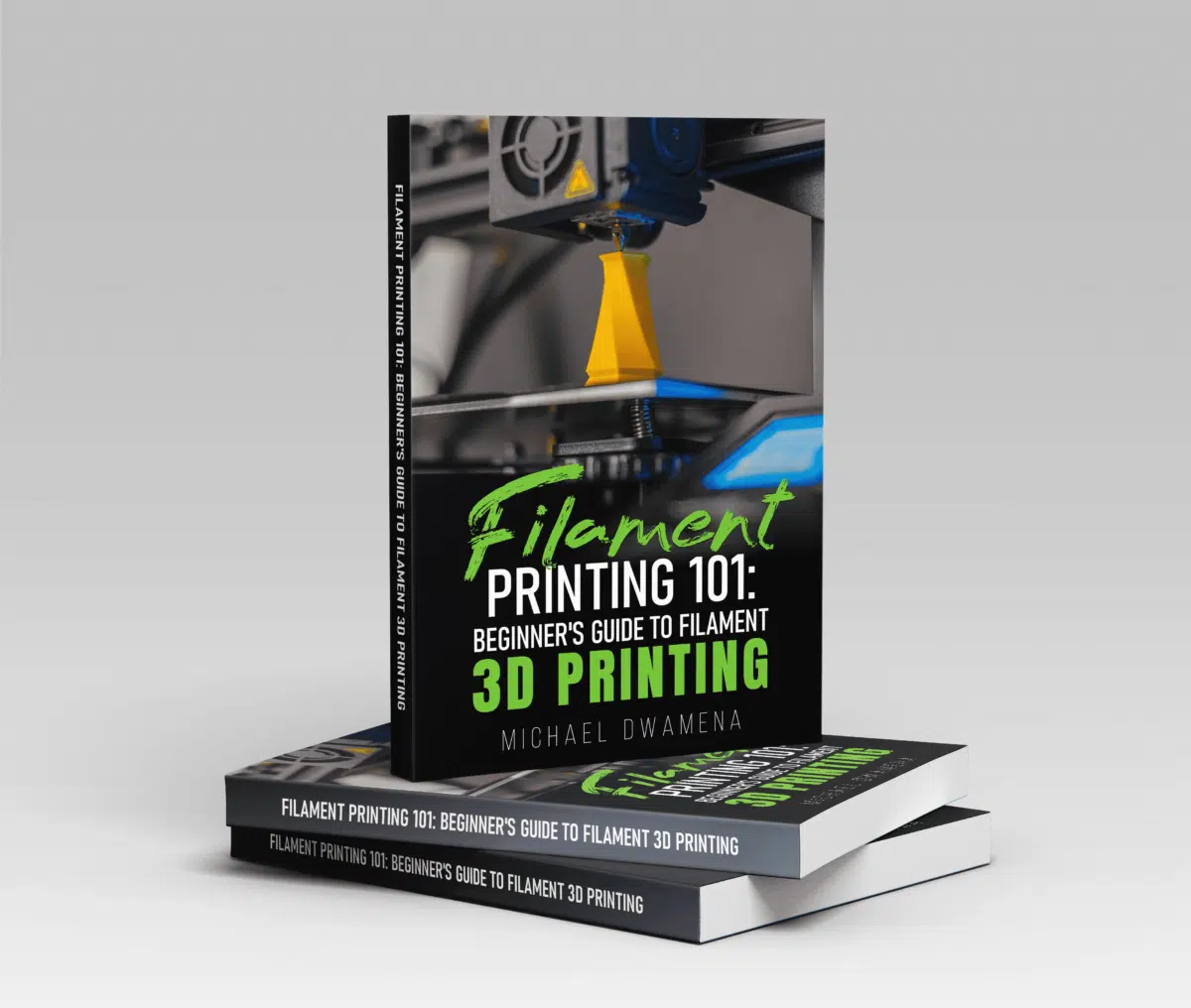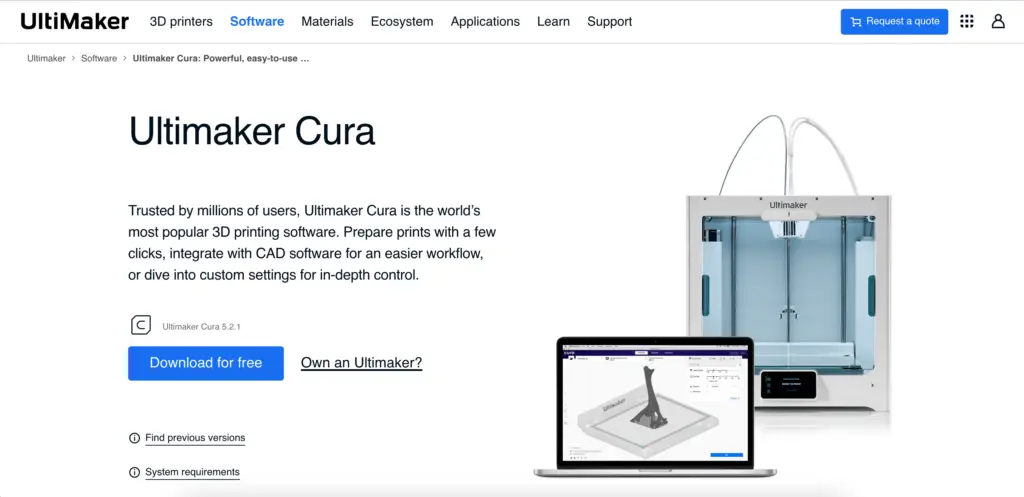Whether you have an SLA or DLP printer, choosing a strong resin is key to printing high-quality parts. When choosing the right material, the most important aspect to consider is the tensile strength.
The strongest 3D printer resins are ultra-rigid and rigid resins with a flexural strength between 100 and 170 MPa. Flexible and semi-flexible resins are the softest, with a toughness between 1 and 50 MPa. These resins break relatively easily, but they are ideal for castable models and other projects that require flexibility.
The table below shows a quick toughness comparison between the various resin types:
| Resin Type | Tensile Strength | Force Resistance | Shore Hardness |
|---|---|---|---|
| Ultra-Rigid Resin | 120 to 170 MPa | 17,400 to 24,650 PSI | > 90D |
| Rigid Resin | 100 to 135 MPa | 14,500 to 19,575 PSI | 80D – 90D |
| ABS-Like Resin | 40 to 91 MPa | 5,800 to 13,195 PSI | 65D – 75D |
| Standard Resin | 65 to 85 MPa | 9,425 to 12,325 PSI | 40D – 80D |
| Clear Resin | 65 to 85 MPa | 9,425 to 12,325 PSI | 40D – 80D |
| PP-Like Resin | 30 to 65 MPa | 4,350 to 9,425 PSI | 30D – 60D |
| Heat-Resistant Resin | 30 to 40 MPa | 4,350 to 5,800 PSI | 30D – 85D |
| Rubber-Like Resin | 10 to 30 MPa | 1,450 to 4,350 PSI | 75A – 80A |
8 Strongest 3D Printer Resins
Before checking the toughness of any 3D printer resin type, it is essential to understand that resins are fundamentally different from FDM (filament) materials.
Resins are liquids that cure under UV light, and some of them will never reach the strength of PLA, ABS, or PETG. With this in mind, here are the strongest 3D printer resins ranked from toughest to weakest.
1. Ultra-Rigid Resin
Ultra-rigid resins are the toughest 3D printer resins out there. These materials have a tensile strength between 120 and 170 MPa, which basically means they resist forces between 17,400 and 24,650 PSI.
While the actual strength varies from material and material and brand to brand, all ultra-rigid resins are majorly used in industrial applications. They are challenging to find on the market and are expensive, but they deliver toughness without brittleness.
These resins are perfect for printing industrial parts that need to support significant loads without bending. Some ultra-rigid resin types are also highly resistant to heat and chemicals.
2. Rigid Resin
Rigid resin often has a tensile strength similar to ultra-rigid resin, and a shore hardness between 80D and 90D.
- Our new Filament Printing 101 Course is just for you! Lean how to create perfect professional prints without all the hassle.
- Don't let common mistakes hold you back, click the link to learn more and get ahead now!
The main difference is that this resin type is readily available on the market and frequently used for figurines, miniatures, and other parts that need a high tensile strength.
Rigid resin typically resists applied forces between 14,500 and over 19,500 PSI, and it is ideal for high-resolution (8K or 10K) printing.
Some rigid resins, especially ceramic-filled ones, offer good heat resistance and thermal stability. These resins are ideal for molds, tooling, and automotive parts.
3. Tough (ABS-Like) Resin
Tough resin is commonly referred to as ABS-like resin, and most brands even name their products this way. The name is owed to the resin’s composition that cures to an ABS-like finish and durability.
Depending on the actual brand and composition, ABS-like resins can have a tensile strength from moderate to tough. At the higher end of the spectrum, these resins boast tensile strengths up to 91 MPa and resist forces up to 13,195 PSI.
They are ideal for producing shatter-resistant parts and functional prototypes, as well as mechanical assemblies. However, you should choose a different resin type if the part has thin walls or if it must resist high heat.
4. Standard Resin
Standard resin is likely the most versatile type. It is named this way because it can be used for a variety of projects.
It also comes in various tensile strengths and shore hardness, suiting hobby and educational or industrial applications alike.
Standard resin is also one of the cheapest options for both SLA and DLP printing. This makes it the best choice for prototyping applications.
Something to keep in mind is that the resin’s color can affect its properties, from tensile strength and shore hardness to resolution.
Gray resin is usually the best choice for parts with fine details, whereas the white kind is ideal for parts with a very smooth surface.
You can use standard resin for any purpose, from arts and crafts endeavors to concept modeling and rapid prototyping. Its greatest downsides include a low heat deflection temperature and brittleness.
5. Clear Resin
Clear resin is very similar in properties and purpose to standard resin, the main difference being that you can cure this resin type to a transparent finish.
In terms of tensile strength and resistance, you can expect it to resist forces from 9,425 to 12,325 PSI, while the shore hardness may vary from 40D to 80D.
Advantages and drawbacks are similar to standard resin, too, but this resin type comes with a few quirks of its own. Perhaps the greatest disadvantage is that optical clarity may change over time, the parts becoming duller and less transparent.
To avoid this, you should only use clear resin for parts that won’t be exposed to excessive UV light. Hence, it is not ideal for outdoor applications.
Clear resin is generally more expensive than standard resin, and you have to use a high-quality material to avoid fast degradation.
6. Durable (PP-Like) Resin
This resin’s name may make you believe that it is tougher than standard and clear resin. However, durable, PP-like resin has a lower tensile strength and shore hardness than standard resin.
When hardened, the material is similar to polypropylene (hence, its name). Polypropylene is a relatively flexible plastic that doesn’t have an excessive tensile strength. In fact, the resin’s tensile strength typically varies from 30 to 65 MPa.
Similar to PP filament, PP-like resin is ideal for printing toys, containers, bumpers, and even dishes. This resin is typically considered food-grade after curing.
However, you should keep in mind that most resins are not food-grade certified, so you may only be able to use your prints for personal use.
To prevent hazards, you should avoid using in the microwave or dishwasher food containers or dishes printed from PP-like resin. Even better, you should only use certified resins (or turn to FDM printing) if you plan to make food containers.
7. Heat-Resistant Resin
As its name suggests, this resin type has a high heat deflection temperature and is ideal for printing objects that require high thermal stability.
However, it is generally quite soft, so not the best choice for models that need both strength and high thermal stability.
That said, you can use heat-resistant resin for casting, mold prototyping, hot air equipment, and similar applications.
Actual applications can vary from printing jewelry to making industrial or medical equipment. Some resins are stronger than others, but most heat-resistant resins have a tensile strength under 40 MPa and do not resist forces higher than 5,800 PSI.
Despite these facts, heat-resistant resin is considered a specialty type and is more expensive than standard.
8. Rubber-Like Resin
As its name suggests, rubber-like resin is flexible. Yet, it has the lowest tensile strength and is one of the weakest resin types.
The shore hardness is A-type, which is a category that includes flexible materials. You can expect around 75A to 80A shore hardness from a quality rubber-like resin, but an actual tensile strength between 10 and 30 MPa.
That said, rubber-like resin is an excellent choice for printing wearables (smartwatch bands, etc.), grips, handles, stamps, and packaging. Rubber-like resin is also ideal for over-molding and multi-material assemblies.
Its greatest downside is the low resistance to UV radiation with rapid degrading in sunlight. Flexible resin is also unsuitable for printing parts with thin walls.
Factors That Influence Resin Strength
Beyond tensile strength and shore hardness, various factors influence the strength of 3D printing resin.
Knowing these factors might help you choose the right resin for your project.
Resin Type
Undoubtedly, the main factor affecting 3D printing resin strength is the type of resin. Flexible, rubber-like resin is the softest and weakest. Ultra-rigid resin is the strongest, but also the most rigid.
For most projects, standard resin offers the best balance between flexibility/stiffness and strength.
Resin Brand
Beyond the resin type, you should also consider the brand – and, overall, the quality of the material.
The reason why the same resin type may have a different strength based on brand is that manufacturers may alter the formulas to include fillers or additives. While fillers typically increase strength, additives may reduce it.
For this reason, you should also check the product label if you’re looking for a specific tensile strength or shore hardness in the material you’re using.
If this information is not printed on the label or provided by the manufacturer, you should switch brands.
Filler Addition
As mentioned, the addition of fillers typically increases the strength of 3D printing resin.
Typically, ceramic, silver, silicon dioxide, and zirconium dioxide nanoparticles can increase the flexural strength of 3D printing resins. Certain fillers, however, such as zwitterion, decrease it.
Once again, it is important to read the label and make sure that the actual strength of the material matches your needs.
Printing Orientation
According to a study on 3D printing resins, a factor that can influence the tensile strength of your model is the printing orientation.
Researchers observed that a horizontal orientation is beneficial in most cases, whereas a vertical orientation tends to decrease it. However, this is mostly true for softer, flexible resins.
In tougher resins, the print orientation may have no influence on the overall flexural strength of your part.
Layer Thickness
Another factor that influences strength is the wall (layer thickness).
Most resins require thicker walls, or they might remain too flexible or brittle, depending on their actual tensile strength.
Post-Curing Time and Temperature
3D printing resin is a type of material that requires UV light rather than temperature to harden. However, the post-curing time and temperature can affect the quality of your prints.
In the same study mentioned above, researchers found that a higher post-curing temperature speeds up the post-curing process, enhancing the print’s resistance.
On the contrary, a long post-curing time is often associated with weaker parts.
Printer Type
Lastly, the type of printer you’re using can have an impact on the resin’s strength.
SLA and DLP printers are the most common for home and professional (but not industrial) use. They both produce good results, but prints are of inferior quality compared to LCD printers that are usually used by industries.
Tips To Improve Durability Of Resin 3D Prints
No matter what resin and printer you’re using, there are ways to make your models more durable.
Cure Resin Properly
The most important thing to ensure the durability of your prints is to cure resin properly. Avoid under-exposure to UV light – most resins don’t dry out or harden due to temperature, but require a UV lamp to harden.
At the same time, you should avoid over-exposure. Most 3D printing resins are susceptible to UV radiation once the material has cured.
Increase Post-Curing Temperature
As explained, a higher post-curing temperature can reduce post-curing time, increasing the material’s durability.
Limit Washing
Unless stated otherwise on the label, 3D printing resins must be washed with isopropyl alcohol to dehydrate the material before removing it from the bed. However, isopropyl alcohol can make resin brittle and reduce its durability.
To avoid issues, dip the part for a minute or two in a container filled with clean isopropyl alcohol, then take it out and wash it in a second container filled with clean alcohol. This process can help you limit cure time.
Alternatively, use a water-washable resin.
Keep Models Hollow
A common mistake when printing with 3D resin is opting for a high infill percentage. However, resin doesn’t behave like FDM filaments.
Since this material requires UV and alcohol curing, a high infill level means that you’ll end up with chunks of resin that you can’t actually cure. This resin will never truly harden, affecting the overall durability of your project.
To avoid problems, choose a lower infill percentage, or increase wall thickness and keep the part completely hollow.
Increase Durability With Post-Processing
Post-processing, including sanding and smoothing of the object, can also increase durability.
The purpose of these operations is to remove minor defects and fill in unwanted gaps. Not only will your parts be stronger, but they also gain visual appeal.
Final Verdict
The strongest 3D printing resin is the ultra-rigid type, but this kind is rarely used for home applications. Standard resin is the best choice for most projects, or you could opt for rigid or ABS-like resin for certain prototypes and applications.
No matter what resin type you’re using, remember that proper curing and post-processing, as well as the right printer calibration, are key to successfully using these materials in 3D printing.




